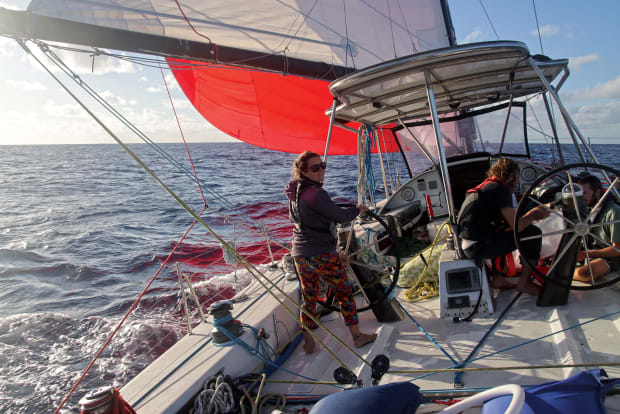
An ex-Vendée Globe racer is an unusual choice as a world cruiser, so why was it ours? Although we already both owned a pair of production boats, my partner, Timo, and I were searching for something to spice up our cruising life. We toyed with the idea of a classic schooner, but weren’t sure we could handle all the varnishing. Another option was to maybe find some kind of an old raceboat. That would certainly make for some exciting sailing! In the end location—or was it destiny?—played as big a role in our final destination as anything else, as we found ourselves anchored just a few boats away from just such a vessel, the Open 60 NV, in Opua, New Zealand.
After doing a little digging, we were fascinated and humbled by what we learned about NV’s history. Designed and built in 1989 by Hungarian sailor Nándor Fa, she took part in four singlehanded around-the-world races in the first decade of her life. Perhaps the highlight of her career was a fifth-place finish in the 1992-93 Vendée Globe with Nándor at the helm, making him the first non-French skipper ever to finish. She entered the Vendée Globe again in 2000, skippered by Russian adventurer Fedor Knovukhov, who sadly abandoned both the race and the boat in Sydney, Australia, due to technical problems. In Australia, the boat underwent further modifications, including having an extra 6ft added to her stern, after which she became a regular competitor in the Cruising Yacht Club of Australia’s (CYCA) many offshore races, including the Rolex Sydney Hobart, in which she came in 8th in 2002.
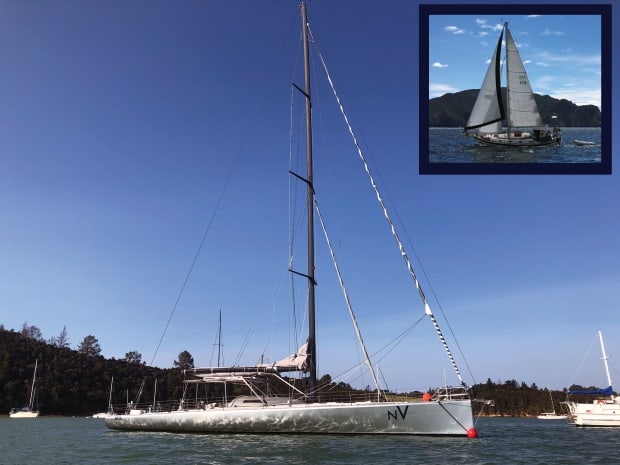
“My whole crew was very fond of her in a way they have not been with my later vessels,” then-owner Michael Cranitch (who is also a past director of the CYCA) recalled. “A great boat to sail downwind, in particular, although a little wet when the speed got into the high teens.”
Finally, in 2014, she was bought by the Millet family, who brought her back home to New Zealand to be used as a high-performance cruiser.
I remember the first time we motored up to NV in our old dinghy. She appeared so grand compared to Carola, the heavy-displacement, full-keeled Young Sun 35 cutter Timo and I were living aboard at the time. Stepping into the cockpit, I was struck by the amount of space. Definitely very “open.” There was none of the usual ducking under solar panels or climbing over winches that we were used to. Lounging around out on deck with the current owners on bean bag chairs, we soaked in the atmosphere. Gazing around at the almost 360-degree view was an impressive experience, to say the least. I could get used to this I found myself thinking. Imagine the parties we’d have!
Next, it was time to go belowdecks. The interior layouts of sailboats always intrigue me, as I’m curious to see how the space is being used. Here, I was expecting to be disappointed as most race boats are pretty spartan. However, that most definitely wasn’t the case with NV. Her owners had already started converting her to cruising mode for their family of three by installing such things as a large table in the galley and a double bed aft. It was also clear they’d already spent a good bit of time both living aboard and sailing her. I loved it. The accommodations were light and airy, and already included everything we’d need: a head, a workable galley, a comfy saloon and, of course, that double bed! There were also plenty of pipe berths for friends and a mini nav station set well aft. Checking out the latter, I could picture NV’s Vendée Globe crews sitting there figuring out their best course or checking the weather. What a great office it would make!
As for Timo, at the same time I was exploring what I hoped would be my new workspace, he was similarly busy planning how we could modify the galley and transform the existing interior with three cabins, a workshop and two heads, complete with bath, no less. Dinghying back to Carola that evening our heads were filled with dreams of a future life aboard NV.
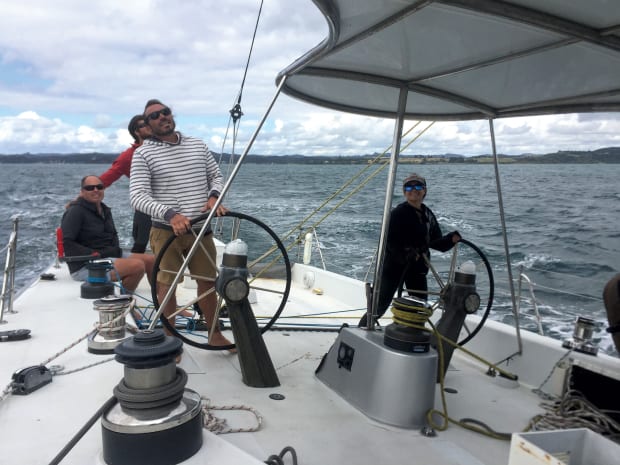
Of course, there were also, potentially, a number of less-than-ideal aspects to living aboard a retired Vendée Globe racer, as our cruising friends were quick to remind us. Take NV’s nearly 14ft draft, for example, which would severely restrict our choice of anchorages. Then there was the potential lack of comfort and privacy, due to the increased exposure to the elements out on deck and the increased exposure to our shipmates due to the lack of separate cabins below. Yet another concern was the potential cost of things like sails, halyards, blocks and other rigging. You get the picture. In the end, though, we decided none of these challenges constituted any kind of a deal breaker.
Next came the sea trial, during which the last of my fears was quickly put to rest. I had been concerned the boat would prove too big, that the loads would mean I wouldn’t feel comfortable handling her on my own. It didn’t take long, though, to realize I couldn’t have been more wrong. With the right care and attention, sailing NV didn’t feel anywhere near as intimidating as expected. The steering was light and responsive. And she was so much fun to sail! Best of all, she felt strong and safe. These old Vendée Globe boats needed to be made bulletproof after all for racing through the Southern Ocean!
That was it, we were sold, and promptly set about the business of selling our current boats and buying NV.
A New Way of Sailing
Fast forward the better part of a year to our first night onboard NV and what comes to mind is the memory of lying in bed listening to the waves slapping against her wide stern. Her empty hull, devoid of the usual cruising boat furnishings, acted like the body of a musical instrument, amplifying every sound. I understood now why we’d found so many pairs of earplugs onboard, left over from the previous owner.
Now that NV was ours, we couldn’t wait to get to know her better. As soon as we finished stashing everything belowecks, leaving a clear cockpit to be filled with friends, we were off. Having only a 38hp auxiliary, it was slow going at first making our way out of Opua harbor into an opposing tide. But as soon as the sails caught the gentle but steady breeze we began zipping along nicely.
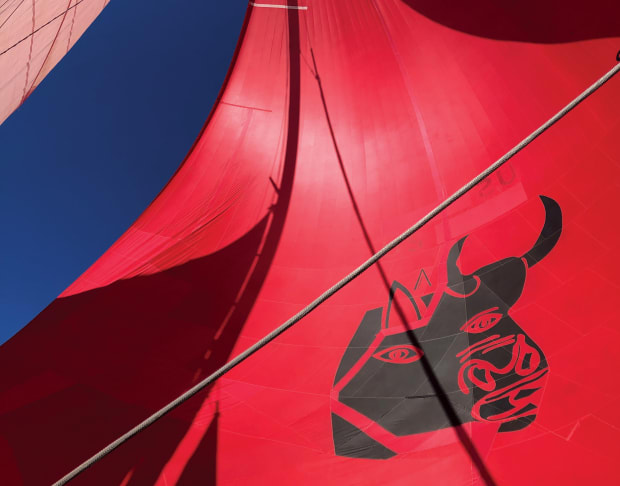
Wanting to make the most of the light conditions and our boatload of enthusiastic crew, it wasn’t long before Timo handed me the helm. “Time to try the gennakers!” he called out with a grin as he headed below. Returning on deck he attached the tack of the first gennaker to the bow chainplate where the Tuff Luff had once been, since the boat’s carbon-fiber bowsprit had not yet been installed.
“Go down!” Timo yelled and I dutifully spun the wheel. Wow, what a feeling! Such a huge sail! It felt like we were flying. Although I was terrified at first at the thought of the boat’s being overpowered, it didn’t take long before I began to relax and chat with friends, admiring the angry bull’s head on the big red sail in front of me!
Meanwhile, with no less than six gennakers to try out, our excited crew kept hard at it, packing and unpacking bag after gigantic bag of sailcloth. The second sail they pulled out was the even larger, “Big Blue,” a sail we immediately recognized from photos we’d seen of NV crossing the finish line of the Sydney Hobart. After that came an enormous yellow spinnaker followed by a smaller, heavy-duty storm sail.
By now everyone had had their fill of taking gennaker selfies, and we had arrived on the far side of the Bay of Islands—a journey that would have taken at least twice as long aboard Carola—which meant it was time to sheet in sails for the trip back to Opua. Only then did we realize the terrible shape NV’s bottom must have been in. Having spent the better part of a year sitting at a mooring downstream from an oyster farm, the rudder, hull and keel were now encased in oysters, barnacles and other marine growth. Of course, with a high-aspect rudder and keel like the rudder and keel on NV, a clean surface is vital for creating the necessary lift when sailing to windward. Any lumps and bumps can lead to making some rather extreme leeway, as we soon found out. Suffice it to say, it wasn’t long before we were braving the icy-cold waters of New Zealand in winter to do some scrubbing!
Despite it being the middle of winter, we spent the next few weeks cruising, not only exploring the Bay of Islands but venturing as far north as Whangaroa, rugged up in thick jackets and woolly hats. Luckily, the 1.5in-thick, foam-cored hull kept us nice and snug below.

NV’s massive belowdecks spaces offer lots of options for a liveaboard couple
As we did so, we continued to be pleasantly surprised by how much faster we could get wherever it was that we wanted to go compared to in the past. Passages that would have taken all day, we now completed in just a few hours, more often than not arriving earlier than planned. This in turn meant we could often stay in bed longer before setting out! One trip that didn’t get any shorter was the one from the companionway to the transom. It always made me laugh whenever friends came to visit and it took me several seconds to make it all the way aft to catch their painters.
NV’s 14ft draft (and lack of a working depthsounder) also took some getting used to, as we were now constantly checking the charts for shallow areas we’d not had to worry about previously. Anchoring also presented some new challenges, as in strong weather we found we sailed around the hook so much we’d often drag, sometimes quite dramatically. After one particularly blustery evening, though, when we had to deploy three anchors to stay put, we finally changed out our main anchor and swivel system, which seemed to solve the problem.
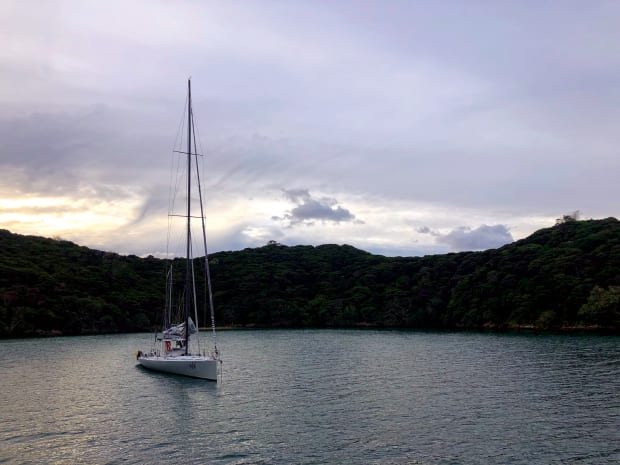
Around this same time, thanks to Fiji having opened its borders again to yachts, we decided it was time for our first bluewater passage. Wanting to be conservative on this, our first ocean crossing aboard NV, we changed out the boat’s regular mainsail for her heavy Dacron delivery main, which only goes up to her top spreaders. We also bent on one of the smaller jibs.
I was curious to see how the boat would behave in the bigger seas offshore and was expecting a very different kind of motion from the one we’d experienced aboard Carola (which we’d nicknamed “C-roll-a” in honor of her less than ideal behavior in a seaway). Friends had warned me NV was going slam into whatever waves we encountered, but she took them beautifully. We were blessed with 15-25 knot westerlies and moderate seas for most of the passage. There was no rolling as the boat glided smoothly through the swells.
We’d rounded up five extra crew for the passage, since there was no autopilot and we wanted at least two crew in the cockpit at all times, with either Timo or me on standby. Despite some of our crew having never sailed before, everyone seemed at ease behind the wheel. Helming soon became a part of the day everyone looked forward to.
Overall, the way the boat is currently set up, we still haven’t ever really pushed it. Nonetheless, we still manage to consistently almost double the speeds of our previous boats without even trying. One thing we discovered during this first passage was that we’d like to re-install some of NV’s old water ballast (or add more lead to the keel) in order to be able to push her a little harder when sailing upwind without having to always heel so dramatically. Our crew also needed to be extra careful and stay attached whenever the weather picked up, as our low freeboard makes it easy to fly overboard! Turning downwind is when the fun really starts, especially with any of those big kites up!
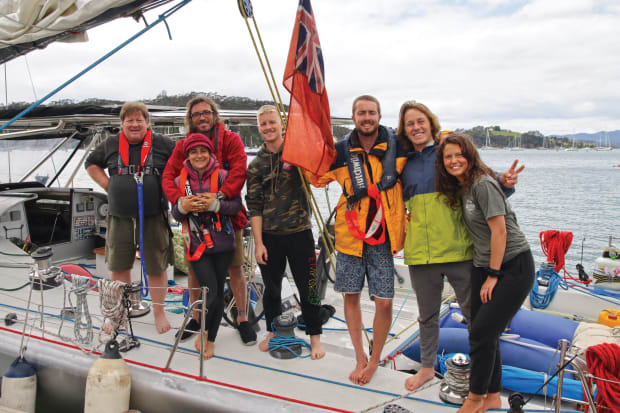
As would be expected, NV is more sensitive to weight distribution and sail trim than our other boats. Cruising boats are usually pretty forgiving if you forget to tweak the sails when the wind changes a few degrees. But on NV the speed change is noticeable whenever the boat is out of trim, to the point where in many ways it reminds me of dinghy sailing. Same thing with weight distribution. A few weeks before we left, we realized the aft end of the boat was forever filling up with water coming in through the rudder bearing. We, therefore, installed a couple of big manual bilge pumps to pump it out. Upon our arrival in Fiji, though, we realize after unloading NV’s many sails that without all that extra weight, the aft end of the boat remained completely dry. In the future, we’ll have to severely limit the weight we bring onboard.
Finally, I’d be lying if I said we don’t enjoy the attention we receive living aboard such a striking vessel. Despite being 30 years old, her slim lines still turn heads. Every time we dinghy back home, our eyes light up when we see NV’s tall black mast and shining silver hull. Even with the challenges we know she’ll present, every time we look at her, she fills us with excitement for our future adventures together. Clearly making the move to NV was the right decision!
Ed Note: For the latest on Joanna and Timo, who also recently welcomed a third crewmember, their son, Nemo, visit sailingnv.com, or check out their YouTube channel, youtube.com/c/sailingnv
Photos by Joanna Hutchinson
March 2022








